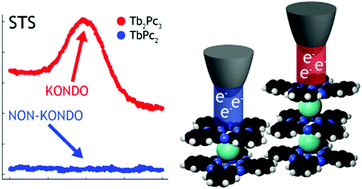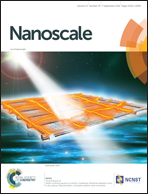On-surface structural and electronic properties of spontaneously formed Tb2Pc3 single molecule magnets†
Abstract
The single molecule magnet (SMM) bis(phthalocyaninato)terbium(III) (TbPc2) has received significant and increasing attention as an exemplar system for realizing molecule-based spin electronics. Attaining higher nuclearity via multi-decker TbPc systems has remained an outstanding challenge, as known examples of Tb2Pc3 systems are only those containing Pc rings with substituents (e.g. alkyl, alkoxyl). Here we report on the spontaneous formation of Tb2Pc3 species from TbPc2 precursors via sublimation in ultrahigh vacuum (UHV) onto an Ag(111) surface. The presence of Tb2Pc3 molecules on the surface are inspected using scanning probe microscopy with submolecular resolution supported by density functional theory (DFT) calculations and additional chemical analysis. We observe the selective presence of a Kondo resonance (30 K) in the Tb2Pc3 species, that we attribute to differences in the orientation of the internal molecular ligands. Formation of triple-decker complexes offers new possibilities to study and control magnetic interactions not accessible with standard TbPc2 molecules.



 Please wait while we load your content...
Please wait while we load your content...